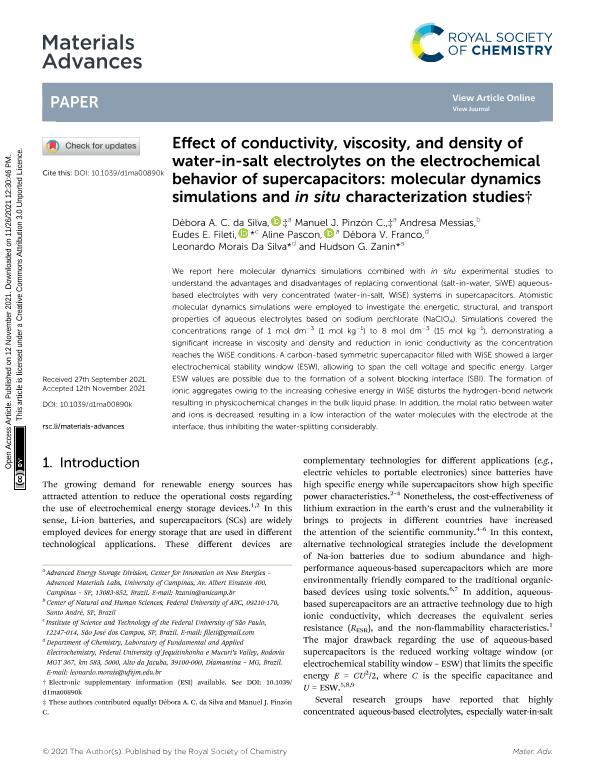Artículo
Effect of conductivity, viscosity, and density of water-in-salt electrolytes on the electrochemical behavior of supercapacitors: Molecular dynamics simulations and: In situ characterization studies
Da Silva, Débora A. C.; Pinzón, Manuel J.; Messias Da Silva, Andresa ; Fileti, Eudes E.; Pascon, Aline; Franco, Débora V.; Da Silva, Leonardo Morais; Zanin, Hudson G.
; Fileti, Eudes E.; Pascon, Aline; Franco, Débora V.; Da Silva, Leonardo Morais; Zanin, Hudson G.
 ; Fileti, Eudes E.; Pascon, Aline; Franco, Débora V.; Da Silva, Leonardo Morais; Zanin, Hudson G.
; Fileti, Eudes E.; Pascon, Aline; Franco, Débora V.; Da Silva, Leonardo Morais; Zanin, Hudson G.
Fecha de publicación:
01/2022
Editorial:
Royal Society of Chemistry
Revista:
Materials Advances
ISSN:
2633-5409
Idioma:
Inglés
Tipo de recurso:
Artículo publicado
Clasificación temática:
Resumen
We report here molecular dynamics simulations combined with in situ experimental studies to understand the advantages and disadvantages of replacing conventional (salt-in-water, SiWE) aqueous-based electrolytes with very concentrated (water-in-salt, WiSE) systems in supercapacitors. Atomistic molecular dynamics simulations were employed to investigate the energetic, structural, and transport properties of aqueous electrolytes based on sodium perchlorate (NaClO4). Simulations covered the concentrations range of 1 mol dm-3 (1 mol kg-1) to 8 mol dm-3 (15 mol kg-1), demonstrating a significant increase in viscosity and density and reduction in ionic conductivity as the concentration reaches the WiSE conditions. A carbon-based symmetric supercapacitor filled with WiSE showed a larger electrochemical stability window (ESW), allowing to span the cell voltage and specific energy. Larger ESW values are possible due to the formation of a solvent blocking interface (SBI). The formation of ionic aggregates owing to the increasing cohesive energy in WiSE disturbs the hydrogen-bond network resulting in physicochemical changes in the bulk liquid phase. In addition, the molal ratio between water and ions is decreased, resulting in a low interaction of the water molecules with the electrode at the interface, thus inhibiting the water-splitting considerably.
Palabras clave:
electrolytes
,
energy storage
,
supercapacitor
,
water-in-salt
Archivos asociados
Licencia
Identificadores
Colecciones
Articulos(INQUIMAE)
Articulos de INST.D/QUIM FIS D/L MATERIALES MEDIOAMB Y ENERGIA
Articulos de INST.D/QUIM FIS D/L MATERIALES MEDIOAMB Y ENERGIA
Citación
Da Silva, Débora A. C.; Pinzón, Manuel J.; Messias Da Silva, Andresa; Fileti, Eudes E.; Pascon, Aline; et al.; Effect of conductivity, viscosity, and density of water-in-salt electrolytes on the electrochemical behavior of supercapacitors: Molecular dynamics simulations and: In situ characterization studies; Royal Society of Chemistry; Materials Advances; 3; 1; 1-2022; 611-623
Compartir
Altmétricas



